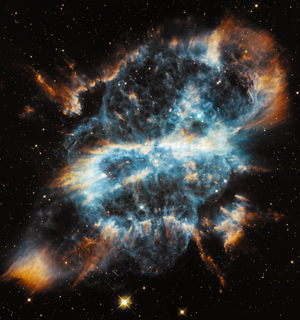NGC 5189
Appearance
| Nebula | |
|---|---|
 NGC 5189 image taken with the Hubble Space Telescope on July 6, 2012. | |
| Observation data: J2000.0 epoch | |
| Right ascension | 13h 33m 32.97s |
| Declination | -65° 58′ 26.7″ |
| Distance | 3000 ly ly |
| Apparent magnitude (V) | 8.2, 8.5p |
| Apparent dimensions (V) | 90 × 62 arcsec |
| Constellation | Musca |
| Physical characteristics | |
| Radius | ~1 ly ly |
| Absolute magnitude (V) | - |
| Notable features | - |
| Designations | Spiral Planetary Nebula, Gum 47, IC 4274, He2-94, Sa2-95, PK 307-3.1 |
NGC 5189 (Gum 47, IC 4274, nicknamed Spiral Planetary Nebula) is a planetary nebula in the constellation Musca. It was discovered by James Dunlop in 1st July 1826, who catalogued it as Δ252.[1] For many years, well into the 1960s, it was thought to be an bright emission nebula. It was Karl Gordon Henize in 1967 who first described NGC 5189 as quasi-planetary based on its spectral emissions.
Seen through the telescope it seems to have an S shape, reminiscent of a barred spiral galaxy. NGC 5189 is symmetrical and is estimated to be 546 parsec [2] or 1,780 light years away from Earth.
References
- ^ Classic Deep-Sky and Double Stars : NGC 5189 (Mus) [1] Southern Astronomical Delights
- ^ "SIMBAD Astronomical Database". Results for NGC 5189. Retrieved 2012-12-21.
External links
![]() Media related to NGC 5189 at Wikimedia Commons
Media related to NGC 5189 at Wikimedia Commons
- NGC 5189 on WikiSky: DSS2, SDSS, GALEX, IRAS, Hydrogen α, X-Ray, Astrophoto, Sky Map, Articles and images
- APOD 1995
- Astronomy Picture of the Day - December 19, 2012
- A Cosmic Holiday Ornament, Hubble-Style
